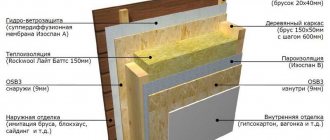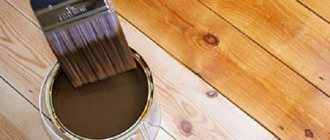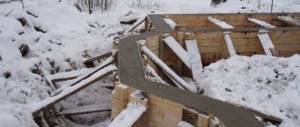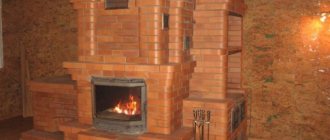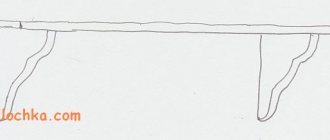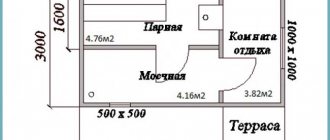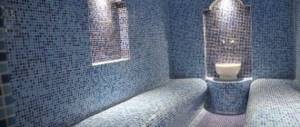Reasons for the formation of condensation in the dressing room
Many people have noticed that water droplets form on a glass jar that is sterilized over steam (the jar sweats).
After heating the jar, droplets stop appearing. The same thing happens if you bring a cold metal spoon to the spout of a boiling kettle. After some time after heating the spoon, droplets will stop forming. It also rains for the same reason. Heated water vapor enters the upper (colder) layers of the atmosphere. In the same way, moisture appears on the walls and ceiling of the dressing room. At the same time, the walls and ceiling become wet and damp. The accumulated drops of water drip down onto the floor, making it wet.
There are several reasons for the appearance of condensation in the dressing room:
- High indoor humidity. Moist air collects in poorly ventilated areas, causing moisture and dampness.
- Warm moist air hitting the cold walls of the bathhouse.
- Lack of ventilation in the room or its insufficient functioning.
In addition, the reason for the appearance of condensation is the lack of necessary thermal insulation between the inner coating of the walls of the dressing room and the outer wall of the bathhouse. As a result, the coating is constantly cooled. All this leads to the constant presence of condensation. It deteriorates the properties of the material from which the building is constructed, reducing its durability. Drops of water falling on electrical wires can cause a short circuit.
One of the reasons for the formation of condensation may be the flow of water under the floor directly from the bathhouse itself. Therefore, it is necessary to make sure that there is no moisture entering through the subfloor. If there is a leak, everything must be done to eliminate it.
When there is a low minus temperature outside, which cools the outside walls and windows of the building - baths, and inside this building the air is usually somewhat warmer, then condensation forms on the entire surface from the inside. Excess moisture accumulates, and since in cold times years, drops of water simply do not have time to evaporate from the surface, then it begins to slowly be absorbed into the facing material of the building and thereby destroy it.
Due to the constant temperature change, after a certain period of time, the owner of the bathhouse most often has to replace the bottom boards in the floor, which begin to rot, become overgrown with fungus and emit an unpleasant odor, with new ones.
Why does condensation collect in the dressing room? There are several reasons influencing this process:
- high humidity;
- improperly performed thermal insulation;
- high air temperature;
- poor ventilation.
One of the easiest ways to remove condensation is to coat surfaces exposed to hot steam with heat-insulating paint. When the bath warms up, the upper part of the walls and ceiling will heat up faster, which will significantly reduce the amount of moisture formed on them. It is also necessary to insulate the room from the outside, moving the dew point closer to the outer layer of load-bearing walls.
If you're willing to spend a one-time investment, you can purchase a dehumidifier that will do all the work for you. It will eliminate excess humidity, which causes condensation, which means that the windows will no longer sweat, the walls will not get wet, and the ceiling will not drip.
Upgrading the ventilation system will help get rid of condensation in the dressing room in winter. One of the easiest ways is to create ventilation holes in the ceiling - strictly opposite each other at opposite ends of the room. This way, excess steam and humidity will escape from the room, and you won’t have to worry about drafts.
Low-power fans can be installed in ready-made ventilation holes to help cope with dampness. Do not forget that during procedures in the steam room, all ventilation holes must be closed with thick fabric or special valves until the end of the session.
Many craftsmen advise installing vaults for water drainage. If you have a so-called leaky floor - gaps are left between the floorboards, then the vault is installed directly under the floor itself and should have a slope towards the drain hole.
In the case of floorboards tightly fitted to each other, the drain is installed in the lowest place. It is imperative to insulate the floor with waterproofing and periodically check its integrity. Craftsmen advise installing valves in the drain to prevent the appearance of an unpleasant odor.
Installing heating devices in the dressing room also helps reduce humidity and eliminate condensation factors. A stove or fireplace heated with wood or heated by electricity will dry the air from steam and prevent condensation from forming.
Don't forget about safety precautions. Any heating devices must be installed strictly according to the rules, because their presence increases the risk of fire. Do not leave stoves and fireplaces unattended, extinguish the coals before leaving and turn off the power from the mains.
For more information on installing heating devices and ventilation in the dressing room, see below.
We invite you to familiarize yourself with: Foundation wall drainage diagram
What is condensate?
During the cold season, low outside temperatures help to cool external windows and walls, as well as lower the temperature of the heated air in the room itself. When this happens, moisture begins to condense in the air, which flows down the windows and begins to be absorbed into the cladding materials of the building. In the winter season, the situation worsens due to the fact that fresh air cannot replace humid air and therefore a process called condensation is repeated again and again. Very often, finding out the main cause of condensation can be very difficult, and sometimes completely impossible. The influence is exerted by many factors, including:
- air temperature;
- poor ventilation;
- thermal insulation;
- humidity.
Ways to get rid of condensation in the waiting room
There are different methods for getting rid of condensation in the dressing room. Among them, several can be noted that allow us to remove this negative factor.
- Ventilation. This method is the simplest and is used when it is not possible to use other methods. Ventilation allows you to remove some of the moist air from the room. This leads to a decrease in overall humidity and stops the formation of condensation. To ventilate the dressing room, just open the front door for a while. The walls and ceiling must be wiped free of moisture.
- Natural ventilation system. With this method, air ducts are installed in the room from below and above, which ensure natural air flow. For effective ventilation, the diameter of the air ducts must be at least 10 cm.
- Installation of forced ventilation systems. Even the smallest forced ventilation system will remove moist air from the room, thereby eliminating the main cause of condensation. In this case, small fans are installed in the air ducts, which ensure continuous movement of air flow. Fans are installed in the lower and upper air ducts.
- Thermal insulation. In this case, thermal insulation panels are installed in order to eliminate the cooling of the internal cladding panels of the walls and ceiling.
- Installation of an additional stove or fireplace. One of the most difficult and expensive ways to combat condensation. This provides additional heating of the room and walls, thereby eliminating the cause of condensation.
How to get rid of the condensation that has formed on the walls and ceiling in the dressing room in simple and effective ways? To answer this question, you can offer several options and actions that will help reduce the level of condensation in the bath:
- It is recommended to make round or rectangular holes for ventilation under the very ceiling, in the opposite walls in the dressing room. The holes must have rectangular sides or a diameter of at least 10 cm.
- Low-power electric fans of several W can be installed in the holes provided for ventilation. These fans will forcefully pull excess moist air outside.
- In winter, if necessary, the vent holes are covered with dense material - a cloth or a sponge while heating the bathhouse - so that the room does not cool down, and then after all water procedures are completed, the holes are opened again.
- The ceiling of the dressing room can also be dried by opening the doors from the heated steam room. Thus, the released warm air will move from one room to another and, of course, will rush upward. Naturally, it is recommended to carry out this activity after completing the main process of staying in the bathhouse.
- It is not recommended to paint the waiting room and steam room, varnish it, or dry some of the wooden products. If necessary, “windy” areas are treated with emery cloth.
- The wooden ceiling in the dressing room can be impregnated with antiseptic, antifungal and moisture-resistant compounds that will protect it from blackness, blueness and other unpleasant manifestations. You can apply impregnation to the ceiling using a roller or brush in several layers - for reliability.
- It is elementary and not superfluous, after you have steamed, to take an ordinary mop with a rag and wipe the ceiling in the dressing room from the drops of water that have formed on it - condensation.
- The reason for increased dampness in the dressing room may also be the presence of moisture under the floor, which drains during washing and accumulates there, and then evaporates through cracks in the floor and settles on the ceiling.
- Under the floor in the dressing room, it is recommended to install several sheets of galvanized iron with a slope in one direction so that water drains and does not accumulate in the underground.
Is condensation dependent on ventilation?
This is a necessary measure, even if high humidity is not that much of a concern. This is due, first of all, to safety rules, because many substances hazardous to humans are stored in the garage. If the garage is equipped with a cellar, it is necessary to consider two systems independent of each other; there should be no air connections between them.
- You will need two pipes of the same diameter. One serves to supply air from outside, the second removes fumes from the room.
- The location of the supply pipe should be approximately 20 - 25 cm from the floor. To improve traction, it runs slightly at an angle.
- The exhaust outlet must be done directly under the flow, because warm air will accumulate there. To enhance air communications, it is necessary to bring the end of the pipe to a height of approximately 1 - 1.5 meters above the garage roof.
- Be sure to consider a mesh at the outer ends of the ventilation pipes to protect against rodents and precipitation getting inside.
- If natural ventilation is not enough to organize normal air exchange, small fans must be installed at the ends of the exhaust and supply pipes. This will significantly increase traction and promote air flow at any time of the year.
- A combined ventilation system involves the use of both options, but it is also better to make special plugs at the ends of the pipes to prevent excessive freezing of the room at subzero temperatures.
Properly organized ventilation will not allow moisture to accumulate on the walls and ceiling. If your garage already has air ducts, you should check their condition regularly. It may be necessary to install additional pipes, or increase the diameter of existing ones. Don’t forget about the grate at the exit to prevent debris, sediment or unwanted “guests” from getting inside. At the upper end of the exhaust pipe it is necessary to install protection from rain and snow, otherwise the effectiveness of ventilation will be very doubtful.
Condensation on the walls in the dressing room is a consequence of improper installation of ventilation. It is known that in the washing room and steam room the air temperature is much higher than in the dressing room. When people leave the steam room, all the steam goes into the room and settles on the walls, flowing down in streams. All this happens due to temperature changes.
We suggest you read: Do you need a waiting room in a bathhouse?
A new bathhouse requires new technologies!
Condensation in the bath: possible causes
Condensation on the ceiling is a fairly typical phenomenon for any cold room, be it a bathhouse or a garage or underground.
We suggest you read: No draft in the stove, what to do
If warm or even hot air enters a cold room, then, naturally, upon contact with a cold surface, the warm air turns into water and settles on the same cold surface.
If you haven’t heated the sauna all week, and it’s frosty outside, then when you flood the sauna stove, all the warm air will rush to the ceiling and “settle” on it as condensation. If you go into the bathhouse after a couple of hours, you will see that there is less condensation, because in 2 hours of heating the walls, floor and ceiling (the entire room) have warmed up and dried to some extent.
You've probably noticed that when you come to your dacha in the spring, everything in the house, including clothes, mattresses and linen, is damp. The same goes for building structures, be it a house or a bathhouse. In the spring, they need to be warmed up for 3-5 days so that the humidity and cold coming from the walls and floor are no longer felt.
If in winter you heat a bathhouse once a week, on weekends, then you need to come on Saturday, heat it all day to dry, and then on Sunday steam and wash in a normal, dried bathhouse. By the way, that’s what all the villagers do: they heat the bathhouse for the day before bath Saturday or Sunday.
With this heating of the bathhouse, condensation will first form not only on the ceiling, but also on the upper logs. In winter, it is more correct to heat the stove moderately, adding firewood very little at a time, so that there is no huge emission of very hot air from the stove, so that the heating of the structures occurs more gently and gradually.
It happens that condensation in the bathhouse forms only on the ceiling, even when the bathhouse was heated the day before. Since only the ceiling is cold, this means the reason is the insufficient layer of insulation in the ceiling.
If the insulation was done with modern materials such as mats or slabs made of basalt fiber or mineral wool, then for a residential building a thickness of 150 mm is needed, and for a bathhouse, in which the room temperature is much higher, the thickness of the insulation should be 200 mm.
A ceiling can be cold if there is no vapor barrier layer, which must be laid before laying insulation made of mineral wool or glass or basalt fiber. Over time, your insulation will pick up moisture and lose all its thermal insulation qualities. You think that you have 200mm of good insulation there (on the ceiling), but there has been nothing there for a long time.
When expanded clay is used as insulation in a bathhouse, the ceiling will also be cold:
- Expanded clay in its thermal properties is inferior to basalt slabs several times and, accordingly, its thickness should be much greater: no longer 200 mm, but 600. So, mineral wool insulation has a thermal conductivity coefficient of 0.045 W/m*k, and expanded clay = 0.15, that is, 3.34 times more, which is 3 times worse for the ceiling of a bathhouse.
- Expanded clay has a fractional nature and the larger the fraction, the more voids there are between the expanded clay pebbles. That is, there is no dense insulation. For insulation it is necessary to use expanded clay of a minimum fraction of 5-10mm.
To make sure that a large (600 mm) thickness of the insulation layer is needed from expanded clay, simply make a thermal calculation taking into account the average winter temperature for your region (let it be -20 C) and the internal air in the bathhouse premises.
Another case is when condensation in the bath is on the ceiling of the rest room and only here. In the steam room and washing room - no. Again, in the winter, visit the bathhouse.
The fact is that in the steam room it is 100 degrees, in the washing room it is 50 degrees, and in the relaxation room it is 10 degrees. Naturally, of all the rooms, the rest room is the coldest. To avoid condensation in the bathhouse on the ceiling of the rest room, there is only one way out: in winter, additionally heat the rest room (dressing room) with some kind of electric heater (heater) to reduce the temperature difference between the rooms.
You can specifically warm up the ceiling of the rest room (dressing room) with some kind of wall heater with a directed air flow. While the bathhouse is heating, such a heater will have time to warm up and dry the ceiling of the rest room.
Usually there is no such problem if a five-walled bathhouse with a steam room and a relaxation room, that is, consists of two rooms located in one log house. Moreover, the sauna stove is heated from the relaxation room. In such a bath, heating of the structures occurs evenly. Accordingly, if there is no cold surface, then there is no condensation in the bath.
Constant condensation in the bathhouse leads to rotting of the wood and an unpleasant odor from mold and mildew. Therefore, when using a bathhouse not only in summer, but also in winter, you need to consider measures for ventilation and drying of rooms and structures.
If in summer to dry the bath it is enough to open all the windows, doors and lift the floor boards, then in winter you cannot open the door. And during a week of no heating, all wooden surfaces that remain wet will not dry out, but will freeze.
We suggest you read: How to clean soot from a chimney at home
In winter, it makes sense to do a special heating of the bath the next day, with which you can dry those surfaces that were wet after the bath day:
- cold surfaces in the bathhouse can be not only ceilings, but also windows, if their design is of a summer version (with one glass and framed from 50mm bars)
- in a small bathhouse, in the absence of a ventilation system, usually the doors are opened for ventilation and then above the doors (the ceiling and the ceiling around the door) will be wet from condensation (from the collision of warm air with the outside cold air admitted through the door)
The reasons for the appearance of condensation in a bathhouse are different. And in each specific case, you need to find it, then somehow solve the problem so that your bathhouse lasts longer.
[content-egg module=GdeSlon template=compare]
When building a new bathhouse, new technologies can be used. The wooden lining inside can be treated with special antiseptics that do not emit harmful fumes. You can also impregnate the wood with the antiseptic composition “Senezh Ecobio” before construction, protecting the deep layers of wood. After this, treat with a special protective coating “Senezh Sauna”, it has increased moisture resistance and an antimicrobial effect.
At the same time, there is no need to paint, varnish, or dry wood structures. It is recommended to lay ceramic tiles on the floor, which are not susceptible to rotting and mold and will last a very long time. If, when building a bathhouse, you properly install ventilation and treat the wood with modern materials, then these actions can minimize the release of condensation on the walls and floor, which will lead to long-term operation. Take care of your health!
Rest room in the bathhouse and ventilation
After visiting the steam room, you need to take a break from the heat for some time, so the bathhouse needs a room that will meet such functionality. The rest room must be ventilated. The equipment for ventilation of the rest room does not differ from similar ventilated systems in other functional rooms.
After visiting the steam room, you must rest in a special room, which must also be equipped with a ventilation system.
If the room is small and there is no access to water, then a natural ventilation system is best suited. Several times a day it is necessary to create a draft in the room.
When the rest room is large and natural ventilation does not give the desired result, the draft for stale air can be increased by installing a combined ventilation system.
If the rest room is combined with a washing room, then to eliminate dampness it is necessary to use a combined room ventilation system with vents in the floor. The pipes of such an vent must go up the structure.
Why does condensation occur in the dressing room and how to get rid of it?
Why does condensation form in the dressing room? This question worries many. Any Russian bathhouse has a room called a dressing room. In it, as a rule, people relax after the steam room, store things, other various attributes and a small fuel reserve for the stove. However, very often the condensation that forms on the walls and ceiling in the dressing room becomes a huge problem, since it is not easy to get rid of it due to the fact that the dressing room directly communicates with the “wettest” rooms.
Building a bathhouse on your country property is one thing, but proper care of it is something completely different. The problem of high humidity with the formation of condensation, which settles on the surface of the walls and ceiling of the bathhouse, leads to the appearance of mold and mildew on them, and wet walls from excess moisture are susceptible to very rapid destruction of building structures and rotting of wooden parts.
It is rare that a stove is installed in the dressing room, which simultaneously performs the function of heating the room and providing natural ventilation through it. In all other options, to get rid of condensation in the dressing room, the most optimal and convenient methods of ventilating the bath should be provided.
Dew point concept
Dew point is the temperature at which water changes from a gaseous state to a liquid. This point is located in the thermally insulating layer of the wall, and is located at different levels in different situations. This point cannot be detected visually; it is only marked on the graph.
The dew point is directly proportional to the humidity level in the room
The most important rule is that condensation forms due to temperature and humidity. The lower the humidity in the room, the lower the dew point.
Factors that influence dew point:
- outside temperature
- wall thickness
- room temperature
- indoor humidity
- humidity outside
